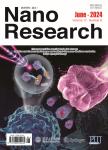Layer-by-layer slot-die coated high-efficiency organic solar cells processed using twin boiling point solvents under ambient condition
作者机构:Hunan Key Laboratory for Super-microstructure and Ultrafast ProcessSchool of Physics and ElectronicsCentral South UniversityChangsha410083China Frontier Institute of Science and TechnologyXi’an Jiaotong UniversityXi’an710054China Printable Electronics Research CenterSuzhou Institute of Nano-Tech and Nano-BionicsChinese Academy of SciencesSuzhou215123China Changchun Institute of Applied ChemistryChinese Academy of SciencesChangchun130022China
出 版 物:《Nano Research》 (纳米研究(英文版))
年 卷 期:2021年第14卷第11期
页 面:4236-4242页
核心收录:
学科分类:0808[工学-电气工程] 0809[工学-电子科学与技术(可授工学、理学学位)] 08[工学] 0805[工学-材料科学与工程(可授工学、理学学位)] 080502[工学-材料学] 0702[理学-物理学]
基 金:This work was supported by the National Key Research and Development Program of China(No.2017YFA0206600) the Science and Technology Innovation Program of Hunan Province(No.2020RC4004) the Special Funding for the Construction of Innovative Provinces in Hunan Province(No.2020GK2024).
主 题:organic solar cells slot-die coating twin boiling point solvent layer-by-layer(LbL) vertical phase separation
摘 要:Layer-by-layer (LbL) strategy has been developed to form bulk heterojunction (BHJ) structure for processing efficient organic solar cells (OSCs). Herein, LbL slot-die coating with twin boiling point solvents (TBPS) strategy was developed to fabricate highly efficient OSCs, which matches with large-scale, high throughput roll-to-roll (R2R) industrialized mass process. The TBPS strategy could produce high-quality thin film without any additive, leading to the optimized vertical phase separation with interpenetrating nanostructures, as well as the enhanced charge transport and extraction. Thus, the power conversion efficiency up to 14.42% was achieved for [(2,6-(4,8-bis(5-(2-ethylhexyl-3-fluoro)thiophen-2-yl)-benzo [1,2-b:4,5-b′]dithiophene))-alt-(5,5-(1′,3′-di-2-thienyl-5′,7′-bis(2-ethylhexyl)benzo[1′,2′-c:4′,5′-c′]dithiophene-4,8-dione)]:2,2′-((2Z,2′Z)-((12,13-bis(2-ethylhexyl)-3,9-diundecyl-12,13-dihydro-[1,2,5]thiadiazolo[3,4-e]thieno[2″,3″:4″,5″]thieno[2′,3′:4,5]pyrrolo[3,2-g]thieno[2′,3′:4,5]thieno[3,2-b]indole-2,10-diyl)bis(methanylylidene)) bis(5,6-difluoro-3-oxo-2,3-dihydro-1H-indene-2,1-diylidene))dimalononitrile (PM6:Y6) OSCs fabricated via sequentially LbL slot-die coating using the TBPS strategy under ambient condition. The research provides a potential route for industrialized production of high-efficiency and large-area OSC devices.



